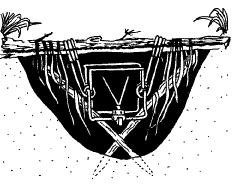|
River Otters | River Otter Overview | River Otter Damage Assessment | River Otter Damage Management | River Otter Resources | River Otter Acknowledgments | ICWDM | Wildlife Species Information |
Contents |
Damage Prevention and Control Methods

Because river otter damage has been minor compared to that of other spectral research and experimentation has been done. Registration of repellents, toxicants, or fumigants for river otter control has not been sought. Alternate aquacultural practices and species, predator avoidance behavior, and use of protective habitat have not been fully explored. Careful assessment should be made of reported damage to determine if non lethal preventative measures can be employed, and to ensure that if any lethal corrective measures are employed, they do not violate state or federal laws. Damage problems should then be approached on an individual basis. Cultural methods and habitat modification are normally not applicable. Opportunities to use repellents, toxicants, fumigants, and frightening devices are infrequent, yet the development of any of these or other effective non lethal approaches would be preferable to lethal control measures.
Exclusion
Fencing with 3 x 3-inch (7.6 x 7.6-cm) or smaller mesh wire can be an economically effective method of preventing damage at aquacultural sites that are relatively small, or where fish or aquaculture activities are concentrated. Fencing is more economical for protection of small areas where research, experimental, or propagation facilities such as raceways, tanks, ponds, or other facilities hold concentrations of fish. Hog wire-type fences have also been used effectively, but these should be checked occasionally to ensure that the lower meshes have not been spread apart or raised to allow otters to enter.
Electric fences have also been used, but they require frequent inspection and maintenance, and like other fencing, are usually impractical for protecting individual small ponds, raceways, or tanks in a series. They are of greater utility as a supplement to perimeter fences surrounding an aquaculture facility.
Back to Top
Trapping

Traps that have been used effectively for river otters include the Conibear® (sizes 220 and 330) or other similar body-gripping traps and leg hold traps (modified No. 1 1/2 soft-catch and No. 11 double long spring). The latter two are usually employed to capture river otters for restocking purposes. In water, body-gripping traps are usually placed beneath the water surface or partially submerged where runs become narrow or restricted (Fig. 3). They are effective when partially sub-merged at dam crossings, the main runs in beaver ponds, or other locations where otters frequently leave the water. Body-gripping traps are also effective in otter trails that connect pools of water or that cross small peninsulas. In these sets, the trap should be placed at a height to blend with the surrounding vegetation to catch an otter that is running or sliding. After ice forms on the surface of streams and lakes, some trappers bait the triggers of body-gripping traps with whole fish. River otter trapping is prohibited in 21 states and one Canadian province. Check local regulations before trapping.
Most of the wild otters used for restocking in recent years were caught with No. 11 long spring traps in coastal Louisiana. These animals were usually caught in sets for nutria, in traps that were set in narrow trails and pullouts where shallow water necessitated that otters walk rather than swim. Leg hold traps are also effective when placed in shallow edges of trails leading to otter toilets or other areas they frequent.
Leg hold traps set in out-of-water trails and peninsula crossings should be covered with damp leaves or other suitable covering.
With the depression of fur prices, nuisance beaver problems and efforts to control them have increased substantially throughout the United States. The killing of otters during beaver control trapping can be minimized by using snares, but they do occasionally sustain moderate injuries. In most situations, snared river otters can be released unharmed. Accordingly, snares are neither the most effective, nor the most convenient devices for capturing river otters or removing them from an area, and therefore are not recommended for either.
Shooting
Shooting the offending otters that cause damage problems will often effectively prevent continued losses. Although otters are shy, they are inquisitive and will often swim within close range of a small rifle or shotgun. Extreme caution should be taken to avoid ricochet when shooting a rifle at objects surrounded by water.
Shooting river otters for fur harvest is legal in four states and one Canadian province. Check your local, state, and federal laws and permits governing shooting, the use of lights after dark, the seasons, and the possession of otter carcasses or parts, to ensure that planned activities are legal.
Back to Top
Damage Prevention and Control Methods
Exclusion
Fence small raceways, tanks, or ponds with 3 x 3-inch (7.6 x 7.6-cm) mesh wire.
Repellents
None are registered.
Toxicants
None are registered.
Fumigants
None are registered.
Trapping
Use Conibear® traps (Nos. 220 and 330), foothold traps (No. 2), and snares to control river otters in damage situations.
For restocking purposes, river otters can be caught in live traps, modified No. 1 1/2 soft-catch traps, and No. 11 long spring traps.
Shooting
If non lethal approaches cannot be employed, shooting with
shotgun or small-caliber rifle can be effective in damage situations that involve only one or two otters.
|
River Otters | River Otter Overview | River Otter Damage Assessment | River Otter Damage Management | River Otter Resources | River Otter Acknowledgments | ICWDM | Wildlife Species Information |
